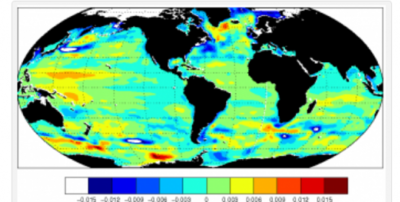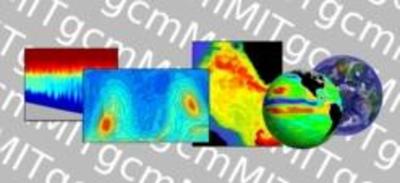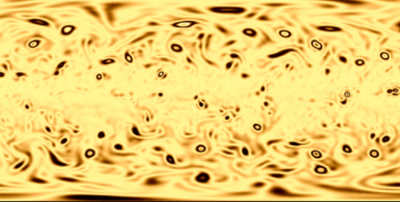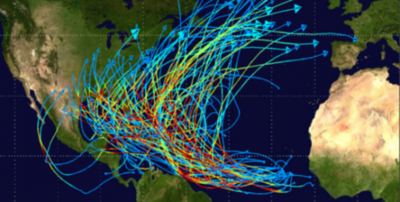Climate Modeling
Climate modeling within PAOC is wide-ranging, encompassing algorithmic, computational, physical, biogeochemical and technological innovations, drawing together elements of computational fluid dynamics, statistics, meteorology, oceanography and computer science.
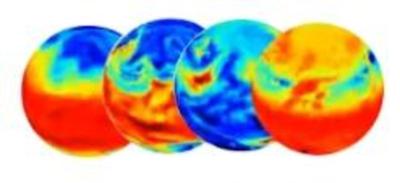 PAOC climate modeling occurs under the umbrella of the Climate Modeling Initiative, a collaboration between MIT scientists to develop a modeling infrastructure for the study of the atmosphere, ocean and climate of the Earth. An approach that emphasizes modeling hierarchies is being pursued, bridging from simple to complex, but based on a common set of modeling tools. Our approach is wide-ranging encompassing algorithmic, computational, physical, biogeochemical, and technological innovations, drawing together elements of computational fluid dynamics, statistics, meteorology, oceanography, cryospheric processes, and computer science. We are keenly interested in the interplay between models, algorithms and code and its mapping to computers.
PAOC climate modeling occurs under the umbrella of the Climate Modeling Initiative, a collaboration between MIT scientists to develop a modeling infrastructure for the study of the atmosphere, ocean and climate of the Earth. An approach that emphasizes modeling hierarchies is being pursued, bridging from simple to complex, but based on a common set of modeling tools. Our approach is wide-ranging encompassing algorithmic, computational, physical, biogeochemical, and technological innovations, drawing together elements of computational fluid dynamics, statistics, meteorology, oceanography, cryospheric processes, and computer science. We are keenly interested in the interplay between models, algorithms and code and its mapping to computers.
Centers & Initiatives
The Climate Modeling Initiative is an open-source collaborative based at MIT which has developed a modeling infrastructure for the study of the atmosphere, ocean and climate of the Earth.
The Center for Global Change Science (CGCS) seeks to better understand the natural mechanisms in ocean, atmosphere and land systems that together control the Earth's climate, and to apply improved knowledge to problems of predicting climate changes. ...
Understanding the ways in which the ocean interacts with the remainder of the climate system is one of the most interesting and challenging of scientific problems.
The MITgcm (MIT General Circulation Model) is a numerical model designed for study of the atmosphere, ocean, and climate. By employing fluid isomorphisms, one hydrodynamical kernel can be used to simulate flow in both the atmosphere and ocean.
Named after the late MIT meteorologist Edward N. Lorenz, a pioneer of chaos theory, the Lorenz Center at MIT fosters creative approaches to increasing fundamental understanding.
Groups
John Marshall's group studies the general circulation of the ocean and its role in the global climate.
Professor Ron Prinn's group works on incorporating the chemistry, dynamics, and physics of the atmospheres of the Earth and other planets, and the chemical evolution of atmospheres. We are also the pioneers of estimating global emissions of non-CO2 g...
Chien Wang's group works on various issues related to atmospheric aerosols, clouds, and tropospheric chemistry, and studies the climate impacts of aerosols and anthropogenic pollutants.
Chris Hill's work centers on how digital computing technology in its broadest sense applies to Earth science and especially the ocean.
Professor Paul O'Gorman's group works on problems associated with the large-scale dynamics of the atmosphere and the hydrological cycle. Areas of particular interest include the behavior of precipitation, moist convection and extratropical storms in ...
The overarching theme of our research rests on the recognition that many elements of the present climate remain poorly sampled by observations, preventing a quantitative mechanistic understanding of climate variability and change over the past decade...
Professor Kerry Emanuel's group works on problems related to tropical circulation and climate.
 PAOC climate modeling occurs under the umbrella of the Climate Modeling Initiative, a collaboration between MIT scientists to develop a modeling infrastructure for the study of the atmosphere, ocean and climate of the Earth. An approach that emphasizes modeling hierarchies is being pursued, bridging from simple to complex, but based on a common set of modeling tools. Our approach is wide-ranging encompassing algorithmic, computational, physical, biogeochemical, and technological innovations, drawing together elements of computational fluid dynamics, statistics, meteorology, oceanography, cryospheric processes, and computer science. We are keenly interested in the interplay between models, algorithms and code and its mapping to computers.
PAOC climate modeling occurs under the umbrella of the Climate Modeling Initiative, a collaboration between MIT scientists to develop a modeling infrastructure for the study of the atmosphere, ocean and climate of the Earth. An approach that emphasizes modeling hierarchies is being pursued, bridging from simple to complex, but based on a common set of modeling tools. Our approach is wide-ranging encompassing algorithmic, computational, physical, biogeochemical, and technological innovations, drawing together elements of computational fluid dynamics, statistics, meteorology, oceanography, cryospheric processes, and computer science. We are keenly interested in the interplay between models, algorithms and code and its mapping to computers.

